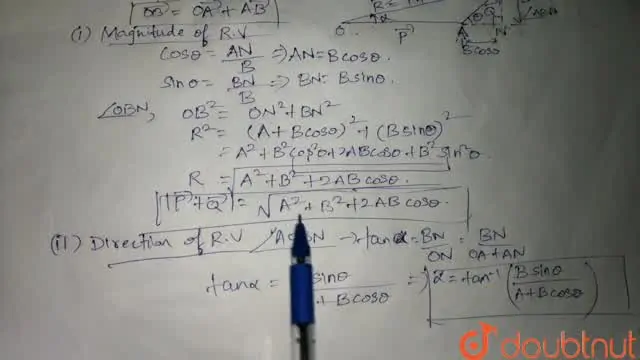Explain in detail the triangle law of addition. Solution in Tamil

Let us consider two vectors →A and →B as shown in figure. To find the resultant of the two vectors we apply the triangular law of addition as follows:
Represent the vectors →A and →B by the two adjacent sides of a triangle taken in the same order. Then the resultant is given by the third side of the triangle as shown in figure.

To explain further, the head of the first vector →A is connected to the tail of the second vector →B. Let θ be the angle between →A and →B . Then →R is the resultant vector connecting the tail of the first vector →A to the head of the second vector →B. The magnitude of →R (resultant) is given geometrically by the length of →R(OQ) and the direction of the resultant vector is the angle between →R and →A . Thus we write →R=→A+→B
−−→OQ=−−→OP+−−→PQ
1. Magnitude of resultant vector: The magnitude and angle of the resultant vector are determined by using triangle law of vectors as follows. From figure, consider the triangle ABN, which is obtained by extending the side OA to ON. ABN is a right angled triangle.

From figure ,let R is the magnitude of the resultant of →A and →B
cosθ=ANB∴AN=Bcosθ and sinθ=BNB∴BN=Bsinθ
For ΔOBN , we have OB2=ON2+BN2
⇒R2=(A+Bcosθ)2+(Bsinθ)2
⇒R2=A2+B2cos2θ+2ABcosθ+B2sin2θ
⇒R2=A2+B2(cos2θ+sin2θ)+2ABcosθ
⇒R2=√A2+B2+2ABcosθ
2. Direction of resultant vectors : if θ is the angle between →A and →B then
∣∣→A+→B∣∣=√A2+B2+2ABcosθ
If →R makes an angle α with →A , then in ΔOBN
tanα=BNON=BNOA+AN
tanα=BsinθA+Bcosθ⇒αtan−1(BsinθA+Bcosθ)
Related Playlists
Similar Questions
Explain the variation of 'g' with latitude.
20:39View SolutionDescribe the vertical oscillations of a spring.
06:06View SolutionDescribe the construction and working of venturimeter and obtain an equation for the volume of liquid flowing per second though a wider entry of the tube
06:06View SolutionTriangle Law Of Addition Of Vectors
View SolutionExplain in detail the triangle law of addition.
06:06View SolutionExplain in detail the triangle law of addition.
06:06View SolutionExplain in detail the triangle law of addition.
06:06View SolutionExplain in detail the triangle law of addition.
06:06View SolutionExplain in detail the triangle law of addition.
06:06View SolutionExplain in detail the triangle law of addition.
04:29View SolutionExplain in detail the triangle law of addition.
02:49View SolutionExplain in detail the triangle law of addition.
53:48View SolutionState and explain the "triangle law of vector addition".
36:30View SolutionState triangle law of addition of vectors.
03:03View SolutionVector Addition||Law OF Triangle /Parallelogram
40:26View Solution


